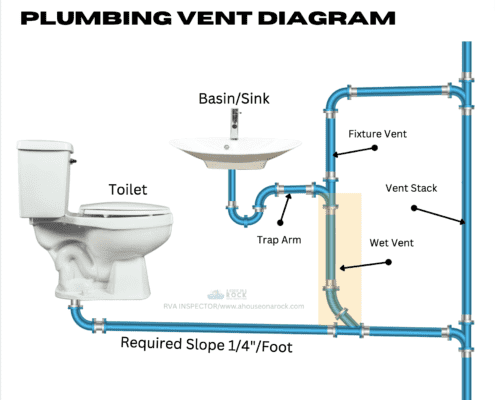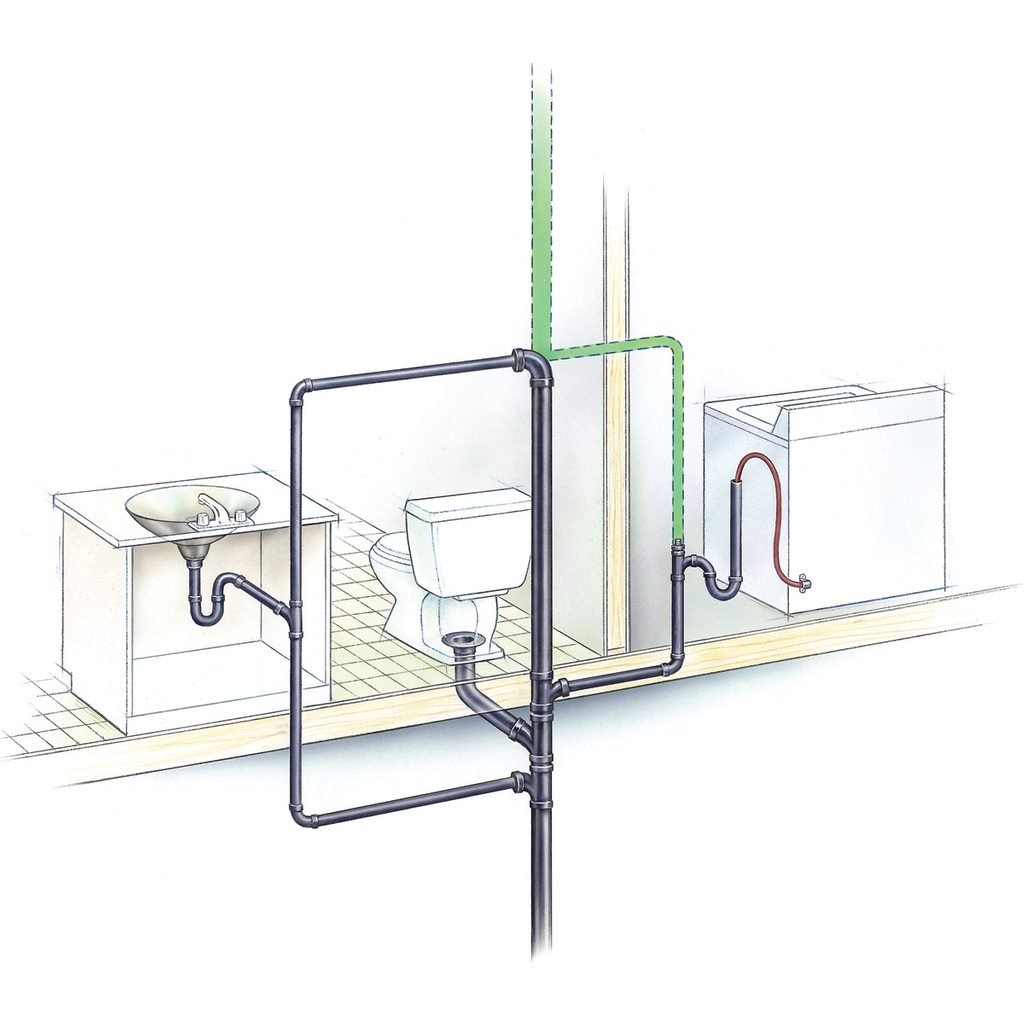The Function of Proper Ventilation in Supporting Plumbing Systems
The Function of Proper Ventilation in Supporting Plumbing Systems
Blog Article
What're your opinions regarding What Are Plumbing Vents and Why Are They Important??

Appropriate ventilation in plumbing systems is often ignored, yet it is essential for maintaining the performance and safety and security of your home's plumbing. Ventilation helps control air pressure, protect against the build-up of damaging gases, and make certain the effective elimination of waste. In this overview, we will discover the value of correct pipes ventilation, exactly how it works, and the advantages it gives your pipes system.
Exactly How Air Flow Works in Plumbing Systems
Air Pressure Law
Appropriate air flow preserves well balanced air pressure within the plumbing system. When water flows via pipelines, it displaces air. Without adequate ventilation, this displacement can develop unfavorable stress, bring about reduce drains pipes or siphoning of water from catches, which can trigger unpleasant odors to leak into the home.
Protecting Against Sewer Gas Buildup
Among one of the most essential features of pipes vents is to avoid sewage system gases, such as methane and hydrogen sulfide, from accumulating within the home. These gases can pose significant wellness risks and are highly combustible. Vent pipes enable these gases to escape securely outside.
Helping in Waste Elimination
Air flow helps in the effective elimination of wastewater by preventing airlocks in the drainage system. When air can flow freely through the vents, it enables water and waste to stream efficiently via the pipelines, minimizing the threat of obstructions and back-ups.
Benefits of Correct Air Flow
Improved System Effectiveness
Correctly aerated plumbing systems run extra efficiently, with less clogs, faster draining pipes, and less pressure on the pipes. This effectiveness extends the lifespan of the plumbing system.
Improved Air High Quality
By avoiding drain gases from entering your home, correct ventilation adds to far better interior air high quality, making your living atmosphere healthier and extra comfortable.
Protecting Against Water Damages
Adequate ventilation aids protect against water from being siphoned out of catches, which can bring about drain gases going into the home and triggering water damage over time.
Actions to Make Sure Correct Ventilation
Consulting Pipes Codes
Constantly speak with neighborhood pipes codes when developing or customizing your pipes system. These codes provide the necessary standards for appropriate venting and ensure your system meets safety criteria.
Routine Inspection and Upkeep
Regular evaluations can assist determine prospective air flow issues prior to they become significant troubles. Maintenance jobs, such as cleaning vent pipes and checking for blockages, are vital for keeping the system in good working order.
Expert Installment
For brand-new installments or significant alterations, it's a good idea to hire an expert plumbing professional. They have the competence to ensure the air flow system is correctly created and set up according to code.
Understanding Ventilation in Plumbing
Ventilation in pipes describes the network of pipelines that permit air to move with the drainage system. These vents serve multiple purposes, consisting of controling atmospheric pressure within the pipelines, protecting against drain gases from getting in the home, and helping in the smooth flow of wastewater.
Sorts Of Plumbing Vents
Key Heap Vent
The main stack vent, additionally referred to as the air vent pile, is the key air vent in a plumbing system. It extends from the major drainpipe line up through the roof, allowing gases to run away and fresh air to get in the system.
Branch Vent
Branch vents attach to the major pile air vent and offer specific components, such as sinks, bathrooms, and showers. These vents make sure that each fixture has ample ventilation to operate effectively.
Air Admittance Valve (AAV).
An Air Admittance Shutoff (AAV) is a one-way shutoff that permits air to enter the plumbing system without the need for a traditional vent pipeline expanding with the roof covering. AAVs are frequently made use of in improvements or areas where setting up a basic vent is unwise.
Indicators of Poor Ventilation in Plumbing.
Slow Draining Fixtures.
If your sinks, tubs, or bathrooms are draining pipes slowly, maybe an indicator of bad ventilation. Poor air circulation can develop a vacuum cleaner effect, making it tough for water to drain correctly.
Gurgling Seems.
Gurgling noises coming from drains pipes are typically a result of air being sucked through water traps because of negative stress in the pipes. This is a clear indicator of insufficient air flow.
Unpleasant Smells.
Sewage system smells inside your home are a warning that your pipes system is not appropriately aerated. This can mean that sewer gases are not being sufficiently aired vent outside, resulting in potentially dangerous conditions.
Typical Air Flow Errors.
Insufficient Vent Sizing.
Making use of small air vent pipelines can lead to bad air flow and stress imbalances in the system. It's important to utilize vents that satisfy the particular requirements of your pipes system.
Improper Vent Positioning.
Placing vents as well much from the fixtures they serve can reduce their efficiency. Proper placement makes sure that air can stream openly and successfully with the system.
Disregarding Code Needs.
Building regulations provide certain guidelines for pipes air flow. Ignoring these codes can result in a system that fails to operate correctly and may bring about expensive repair work or health hazards.
Conclusion.
Proper ventilation is an essential part of any type of pipes system, guaranteeing that it works successfully and securely. By recognizing the value of air flow, identifying the indicators of poor ventilation, and taking actions to keep your system, you can prevent expensive concerns and shield your home's air quality.
4 Things You Should Know About Your Plumbing Vents
What Plumbing Vents Are
Also called a vent stack, a plumbing vent is a vertical pipe attached to your drain line that runs through your roof. The plumbing vent pipe, or plumbing air vent, removes gas and odors from your plumbing system and allows fresh air to enter the pipes, helping the water to flow out of the drain pipes.
What Plumbing Vents Do
Plumbing vents have two basic functions. One of which is to allow unpleasant smelling wastewater and sewer gasses to escape your plumbing system instead of entering your home. Plumbing vent pipes are typically located on roofs, away from windows, to ensure the fumes exit the home completely.
The other function of the plumbing vent is to move fresh air into your plumbing system. This helps move water through every plumbing fixture in your house, like toilets and sink drains. Think of the way in which you need to let a little air into the bottle as you pour soda in order to make the drink flow smoothly.
Different Types of Plumbing Vents
True vent: This is the most common vent option. In simplest terms, a true vent is a vertical pipe attached to your drain line that exits through the roof. They often function as the main vent that other fixtures can connect to. Re-vent pipe or auxiliary vent: Attached to the drain line near specific plumbing fixtures, re-vent pipes run up and over to connect to the main vent. Common vent: Two plumbing fixtures installed on opposite sides of a wall are typically tied into the vent stack using something known as a sanitary cross. Wet vent: This venting option operates as a drain pipe and a vent at the same time. Wet vent drainage systems drain water from one fixture while venting the air from another. Although they’ve been used for over 100 years, wet vent systems have only recently been added to the plumbing code in many areas. If you’re planning on installing one in a bathroom remodel, make sure you check your local code prior to construction. Loop vent: For free-standing fixtures like kitchen island sinks, loop vents are ideal. These vent pipes run under the floor, rise from the P-trap, and create a loop inside the cabinet sink. Air admittance valve: An AAV is a one-way mechanical valve typically installed at the site of the plumbing fixture. AAVs allow venting to occur without having to tie into a larger venting system. They’re ideal for venting fixtures where you aren’t able to easily connect to an existing vent system. Common Plumbing Vent Issues
Although vent pipes typically don’t have water flowing through them, they’re still subject to many typical plumbing issues. For example, clogs are one of the most common problems associated with sewer vent pipes. If your vent pipe gets clogged, all of your plumbing fixtures tied into the vent stack will be affected.
A sink with a slow drain that bubbles and gurgles or a strong sewage smell around your toilet are both indicators that your toilet vent pipe is clogged. Because most vent pipes exit through the roof, old leaves, twigs or even a bird’s nest could be clogging the pipe.
Clogs in your vent pipe system cause a buildup of negative pressure, meaning that water won’t be able to flow out of your home very well. It’s similar to putting your finger over the opening of a straw to trap water inside. When you remove your finger, the water is able to flow out of the straw.
If you suspect you have any blockage in your vent, make sure you have a professional come examine the situation. Left unchecked, a blocked air vent can lead to other costly repairs, like leaks and sediment buildup.
Under Pressure
Pipe vents are essential aspects of a home’s plumbing system. Owning a home means learning about all sorts of things you never put much thought into before. But by understanding as much as you can about the important systems of your home, you can keep those budgets intact and those anxiety levels low.
https://www.homeserve.com/en-us/blog/home-improvement/plumbing-vents/

We were brought to that write-up about What Is A Plumbing Vent & How Do They Work? through an acquaintance on our other web page. Do you know about another individual who is fascinated by the niche? Why not promote it. I recognize the value of your readership.
Click Here Report this page